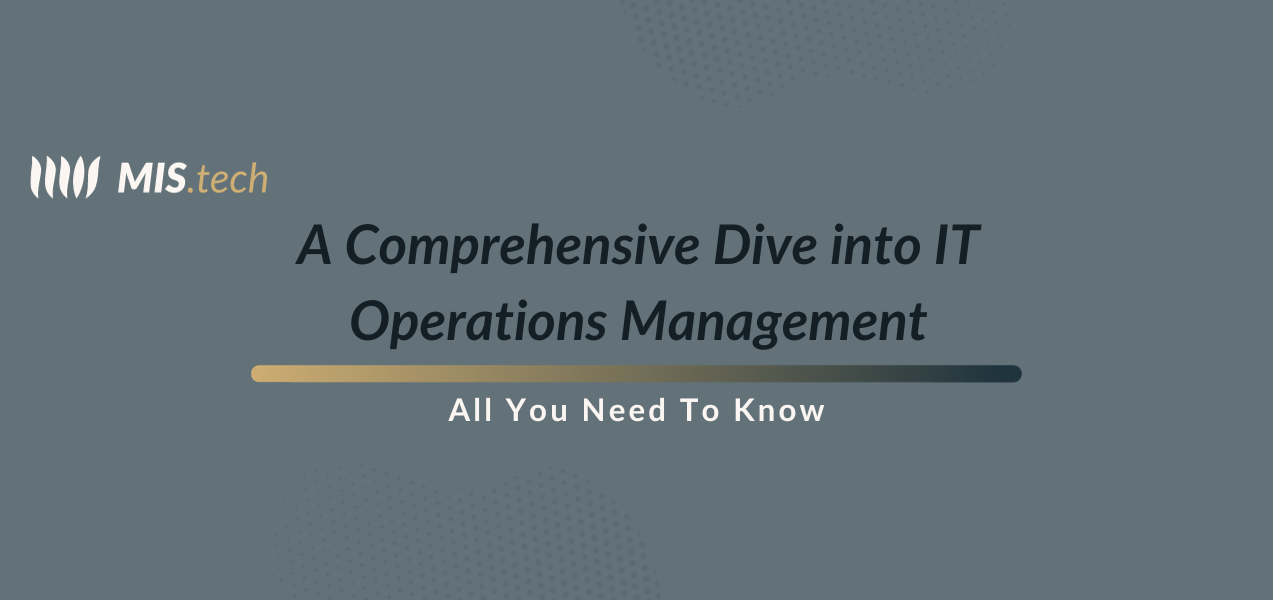ITOM is the totality of the people, tools, and resources that manage an organization’s IT components and application needs. It is used by organizations, system admins, programming teams, and business managers to maintain and control IT services used in powering the organization. IT management operations include providing IT services to internal and external users, software and hardware support, and networking. This guide covers the importance, challenges, impact, and strategies of IT operations management.
Introduction to IT Operations Management

ITOM uses service delivery frameworks to administer and meet the information technology requirements of a business. It creates a workflow that ensures smooth communication between business operation teams and IT teams. This team collaboration aligns all parts of the organization toward achieving its business goals. Effective ITOM ensures that organizations can solve their IT needs as they occur and provide IT support for their staff.
What is operations management?
Operations management focuses on designing, overseeing, and optimizing the processes and activities that produce goods and services within an organization. It involves planning, organizing, coordinating, and controlling various resources, such as people, materials, equipment, and technology, to ensure efficient and effective production or service delivery. The primary goal of operations management is to improve productivity, reduce costs, and enhance the quality of products or services while meeting customer demands and organizational objectives. It plays a critical role in achieving operational excellence and competitiveness in the business world.
Understanding IT Operations Management (ITOM)
ITOM is the management of IT operations within an organization to allow it to run its business efficiently. ITOM includes maintaining and administrating a company’s services and applications, hardware and software, and ITOM processes. The aim is to create an environment where a business does not have to worry about IT needs because it can effectively manage them.
Cost-cutting and efficiency are vital reasons for using ITOM within your organization. ITOM teams will help you to lift the burden around your IT infrastructure. You will no longer have to worry about supporting your staff or implementing the latest IT infrastructure within your business.
ITOM Software
ITOM software helps organizations integrate legacy software systems with traditional IT systems. It also allows syncing processes and services throughout an organization to ensure smooth operations. This service is an important part of any business because it improves the management capabilities of your staff. They could share information across the organization, promoting effective management processes.
Implementing ITOM will help businesses scale their operations because they can better integrate IT solutions. ITOM is covered under the ITIL framework and includes processes handled by the management of help desk services. Management solutions are designed to be stable and available for use when needed.
Difference between ITSM and ITOM
The ITSM vs. ITOM debate is a popular one in the IT industry. Although both seem similar, there are key differences between ITOM and ITSM, which include:
- ITOM vs. ITSM is a services vs. operations standoff. ITOM provides administration for IT operations, while ITSM is concerned with the proper controls and oversight of IT services.
- ITOM focuses on the technical management of operations, while ITSM handles customer service.
- ITSM software provides IT customer service in a way that information is spread across the organization rapidly. ITOM helps the IT environment run smoothly and efficiently while saving time.
- ITSM usually deals with external users, while ITOM focuses on internal procedures of IT infrastructure.
Importance and Benefits of IT Operations Management

ITOPS management involves administering a company’s IT needs, including support, upgrades, and hardware/software changes. The goal of ITOM is for management teams to help businesses meet their set goals using the IT infrastructure at their disposal. Some benefits of ITOPS management include:
- It helps businesses cut costs and increase their profits by optimizing their processes. Companies can make more money when they operate efficiently and reduce burn rates.
- Businesses can serve their customers better, which leads to happier and repeat customers.
- Organizations will experience little to no downtime as their services will always be available to users.
- Operation costs are reduced because businesses can maximize the IT tools available, and it reduces/eliminates redundancy.
- Disaster recovery efforts are improved with backup management. Businesses can recover critical data if a server crashes or suffers an external attack.
Key Roles of IT Operations Management
The roles that ITOM covers include their responsibilities within a business environment. These responsibilities are the day-to-day tasks that ITOPS management teams use to support their host organization. These include:
- Network infrastructure management: This is the administration or support for hardware and software devices connected to an organization’s network. This includes communication with external servers and cloud-based computing services.
- Incident management: This part of operations management involves solving unplanned IT problems and communicating information about incidents to the service desk. It also includes how management crews handle information about incidents and network outages.
- Asset management: This management ensures that an organization’s IT assets are adequately utilized, upgraded, maintained, and deployed.
- Application management: This is the daily management of all applications that run on an organization’s IT infrastructure.
- Problem management: This management refers to how ITOPS management groups handle underlying problems in a business’s IT infrastructure.
- Service request management: This includes the management of help desk operations and service requests using a process known as the ITIL framework.
- Data management: This is managing a company’s internal and externally generated data and the system for integrating data into the business.
- Change management: This part of operations management concerns handling changes to a company’s IT infrastructure. It covers the integration, lifecycle, and upgrade of manual processes and handoffs to a business’s IT infrastructure. It also ensures these changes go smoothly without a hitch.
- Event management: This deals with managing the lifecycle of IT services within a business. It brings visibility into the IT architecture and how each part interacts.
- Availability management: This ensures a company has IT services available when needed.
Best Practices for IT Operations Management
Implementing ITOPS management is important, but doing so within accepted best practices is the only way to maximize the benefits. These practices are universally accepted guidelines within the industry that guide how ITOPS management should be handled. Here are a few of the best approaches for ITOPS management:
- Existing management operations must be understood before any changes or alterations are made. This would allow for a proper understanding of how existing systems work and the areas where it is lacking.
- The leadership of an organization must be aligned with the objectives of ITOPS management. IT management operations is a resource-demanding area of a business, and decision-makers within the company must be willing to commit to its long-term success.
- The goals of an organization must be identified and prioritized as it will guide the IT operations towards achieving these goals.
- A data audit is necessary to count what exists and what the business needs accurately. It also ensures that the existing infrastructure can appropriately integrate with new services.
- Automation is the bedrock of IT operations because it eliminates the manual performance of repetitive tasks. It also guarantees that work is performed consistently and at a high level.
How ITOM enhances service management
IT service management deals with the comprehensive way IT services are delivered to the people and businesses who need them. ITOPS management handles the tools, environment, and important processes for IT service delivery. IT operations management also ensures that software systems with traditional on-premise structures integrate properly with newer systems. Therefore, ITOPS management is an important component of IT service management. Properly working your business’s IT management will ensure that you have reduced operational risk, better server performance, and happy customers.
Challenges and Solutions in IT Operations Management
There are numerous Operations management challenges, but solutions can be implemented to make an operations manager’s life easier. Although effective ITOM offers businesses great advantages, ITOPS management may only provide sufficient gains if properly navigating these challenges. Operations managers take extra care to navigate these challenges as each must be uniquely handled depending on the company’s industry, size, and infrastructure.
Common challenges faced by IT operations managers
IT managers’ challenges are usually unique to their situations, but some common ones cut across all businesses, including:
- Controlling Costs: ITOPS managers are tasked with implementing processes and making decisions that reduce a business’s IT costs. These decisions include team size, purchasing new IT solutions, and providing solutions within the company’s budget.
- Security: Managers must ensure all IT services are secured from external and internal threats. This includes backing up data, implementing access controls, and creating security protocols.
- Staying Current: ITOPS managers must ensure that the business uses the latest technology when necessary. They will also research the latest IT technologies and how integrating them can improve efficiency in IT operations.
- Improving Efficiency: Managers must look for ways to improve efficiency and streamline processes. Tracking activities and how to optimize the time spent on each activity is a key part of this process.
- Ensuring IT Resource Availability: IT resources must always be available to meet the demands of the business. ITOPS managers must ensure that the organization has all the resources necessary to function effectively.
- Managing Distributed Environments: As a business grows, so does its IT infrastructure to meet its needs. Managers must ensure that these complicated systems work harmoniously to support the business.
The role of automation in ITOM

Automation is important in ITOPS management because it eliminates redundancy and improves efficiency. Managers should always automate repetitive tasks to free up IT resources for more demanding areas. Using automation to monitor and cater to IT infrastructure will reduce the time needed to integrate new solutions. Reducing human interaction in the administration and management of IT goes a long way in reducing costs. Another valuable way it helps is through proactive optimization of IT resources.
Implementing ITOM solutions for efficient operations
Effective IT management provides solutions for the problems faced by IT managers in the field. These solutions help managers achieve their goals by solving/eliminating roadblocks. Solutions used by managers include:
- DevOps: A DevOps approach will help managers properly interface with different teams and automate processes. This approach will make operations faster, better, and run smoothly.
- IT Monitoring: IT monitoring tools ensure that potential issues are identified before they become problems. This will allow systems to run smoothly and reduce the possibility of incidences.
- Security Strategy: A security strategy reduces the attack surface area a business faces. It will also protect a business’s internal and external processes by constantly scanning for and preventing threats, implementing security protocols, and responding to security incidents.
IT Operations Management and Emerging Technologies
Emerging technologies can potentially disrupt business operations because it has the potential to change how users and actors interact with each other. The same can be said about how these technologies will affect IT management. Quantifying how these technologies will impact IT operations when integrating a new service can be hard. However, managers need to explore the pros and cons of these technologies and the best way to take advantage of them.
The impact of the Internet of Things (IoT) on operations management
IoT (Internet of Things) is simply the connection of everyday devices to the Internet. Within operations management for IT services, IOT will bring a few benefits that will make managing IT infrastructure easier. It will improve real-time insights as information from every part of a business’s IT infrastructure can be reliably collected. IoT will also increase safety and security while optimizing IT resources.
How ITOM supports endpoint management
ITOM supports endpoint management by ensuring the safety and security of devices on a company’s network. It prevents and reduces attacks from interior and exterior elements by managing access to the IT network. Network administrators can also manage the endpoint access from a single interface, allowing smoother controls.
Exploring the role of ITOM in DevOps
DevOps and ITOPS go together because they work together to achieve the same aim. DevOps brings together different teams together to achieve the same goals. It helps management personnel get the most out of their operations by facilitating quick releases of the relevant software and incorporating feedback into future releases. It also provides a system for IT management personnel to track changes made to the IT infrastructure of a business, which improves the efficiency of staff who interact with the infrastructure.
Key Functions and Strategies in IT Operations Management
What are the functions of IT management, and what are the effective strategies for implementing them? In this section, we will review some of the crucial functions of OPS management, and the strategies managers use to implement these functions.
Overview of operations management functions
The functions of management operations are the roles expected to be filled by their teams. These roles include quality control, forecasting, supply chain management, and delivery management, ensuring a business can run smoothly. Each role forms cogs in the wheel that keep the organization turning.
Effective Strategies for IT Operations Management
These strategies are the lens through which IT operations are implemented within a business. Each strategy points towards the main goals of the business, and these include:
- Corporates strategy.
- Cost-driven strategy.
- Product development strategy.
- Customer-driven strategy.
- Supply chain strategy.
Distinguishing ITOM from other management disciplines
IT management operations (ITMO) are different from other management disciplines because it is concerned with IT infrastructure management. It is also concerned with managing the individuals that support the IT services within the business. ITMO explicitly concerned with the interior and exterior IT infrastructure that makes a business work. Other management disciplines manage other sections of a business or organization.
Conclusion
In conclusion, IT management operations are important within any business organization. It ensures that all their IT needs are met and that they can meet their business goals. Committing to a long-term plan for your IT needs is important as a forward-thinking business. With proper management, your business will be catapulted to the pinnacle of your industry.
The growing importance of IT Operations Management
IT management operations have become increasingly important in today’s internet world. Businesses need relevant IT management if they hope to compete with their peers. It is not enough to use IT services; they should also ensure they adopt the latest technologies to stay caught up. It also promote visibility of existing IT infrastructure and the areas where there can be improvements.
Final thoughts on ITOM and its impact on organizational success
Great IT management operations have a positive impact on the success of any organization because it helps businesses manage their IT processes. This management improves efficiency and ensures that businesses can serve their customers better. Every company needs to implement proper IT management operations for better organizational outcomes.


